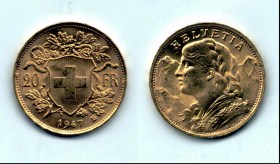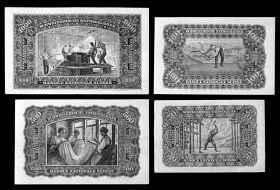In crises, international investors rely on the Swiss franc. It owes its reputation as a stable currency to a policy that often put currency stability before the interests of the export economy.
This content was published on May 18, 2023
There are many hip-hop songs about the dollar. But since the economic crisis of 2008, the Swiss franc has also increasingly appeared in songs – as a symbol of wealth alongside cocaine, champagne and Maybachs.
R’n’B singer Ryan Leslie even dedicated a whole song to the currency with “Swiss Francs” in 2012. He drives around the Zurich lake basin in his Porsche to opulent wind instruments and beats and raps in front of the Grossmünster about his Swiss francs on a Swiss account: the epitome of his fantasized success.
The Frank’s appearances in pop culture are rarely so glamorous. But its development as a currency is impressive. In 1914 you got more than 5 francs for one US dollar, today a little less than one franc.
For a pound you got 25 francs, today one franc and 10 centimes. Even now, in 2022 and 2023, it is defying inflation better than many other currencies.
The holy war for a stable currency
The Swiss franc was overvalued early on: Shortly after its introduction in 1850, it was readily melted down because its silver yielded more than its agreed value. For a long time it was of little use as a currency, remaining just a slender appendage to its French father, the franc.
“In the 1880s and 1890s, the franc always tended to be a bit weak because there was no consistent monetary policy,” says historian Patrick Halbeisen, who heads the archives of the Swiss National Bank.
The National Bank (SNB) provided this consistent monetary policy from 1907 onwards. From then on, she opened the floodgates of money production and closed them again – her decisions shape the franc to this day.
In the years when it was founded, it strictly adhered to the international gold standard: the value of banknotes issued had to be covered by a specified proportion of gold in the SNB vaults.
The fact that Switzerland was spared World War I laid the foundations for the previously inconspicuous Swiss franc to rise to the league of hard currencies. The franc established itself as a crisis currency, as a safe haven for wealth.
Then in 1929 the stock market crashed and all currencies began to fall in value rapidly. In Switzerland, the gold link remained true and the franc remained relatively stable, which put the export economy under pressure.
In 1936, just three countries still held the gold standard: France, Switzerland and Holland. Then the Federal Council decided by emergency law to reduce the gold backing of the Swiss franc.
Historian Halbeisen sees this long wait primarily as an expression of an internalized mentality of the gold standard: “One could not imagine how a stable monetary policy could be conducted without being anchored in gold. However, the SNB was not alone in this. Only other central banks saw themselves forced out of the market to give up the gold backing.”
Despite the positive economic effect, the pain of parting also prevailed outside the central bank. The “Finanz-Revue” spoke of a “national disaster” and an “economic coup d’etat”.
Ernst Laur, a Swiss peasant leader, looked back on this event with a lot of pathos: “Mother Helvetia (…) had to descend from her place of honor, the seat of good faith. (…) Yes! that would be one It would have been a feat if (…) our currency had remained the fixed pole on which the currencies of the whole world could have been aligned.”
Fritz Leutwiler, director of the SNB from 1959 to 1974, later described the SNB’s commitment to a stable currency and the gold standard as a “holy war”.
In the monetary system of stable exchange rates that prevailed after 1945, the dollar became the key currency – but it was still docked to gold. Here, too, Switzerland meticulously adhered to the specifications until the end of the 1960s. Leutwiler saw this as part of monetary “fair play”.
The Currency Whip
At the end of the 1960s, the given course could hardly be maintained, the dollar had stumbled, and the financial flows into the franc could hardly be fought. In 1973, the SNB therefore switched to a system of flexible exchange rates.
The Franc now had no firm anchor. Together with Germany, Switzerland now relied on monetaristic concepts: They communicated the expected increase in the amount of printed money.
Inflation was now the focus of stabilization efforts, no longer the value of the Swiss franc – which immediately led to a massive appreciation in the prevailing economic crisis. As a result, the slump in the Swiss economy during the oil crisis of the 1970s was more severe than in almost any other country.
The export industry shrank unprecedentedly, especially the textile industry suffered. Only unemployment remained moderate because 250,000 so-called “guest workers” had to return to their home countries.
Ingredients for trust and stability
Stable country, stable money, stable lifestyles: In an international comparison, a lot is going well in Switzerland.
In this series, SWI swissinfo.ch looks at trust in institutions, the basis for functioning democracies.
We look at the historical reasons why boredom is the biggest problem for some in Switzerland, how trust is today – and what stumbling blocks Switzerland is facing.
End of insertion
In 1978 they gave in, the SNB specified an exchange rate target to ward off the franc buyers. One franc should be worth no more than 80 German pfennigs – an announcement that calmed the franc market for years.
Switzerland experienced a similar phase at the beginning of the 1990s – the controversial discussion about these years continues among economists to this day. Here, too, the SNB allowed the franc to rise in value for a long time. Only in 1996 did it communicate a goal to the markets – again at the expense of the export economy.
In response to the economic crisis of 2008, the Swiss franc rose again. In 2011, the SNB pegged the franc to the euro. When they removed this coupling in 2015, the value rose sharply again. This time with less brutal consequences for the industry. Enthusiasts at the time praised the strong franc as a “currency whip” driving the Swiss economy to be more efficient.
Daniel Lampart, chief economist at the Swiss Confederation of Trade Unions, sees it differently: “Every phase of the appreciation of the franc has led to painful job losses.” In the 1970s it hit the watch industry, in the 1990s it hit the electrical and railway industries, and now it’s the food and machinery industries. “It always hits icons of the Swiss economy: Toblerone is going east. The Matterhorn is disappearing from the Toblerone signet. The strong franc is never the only problem – but the strong franc is killing many jobs,” says Lampart.
Lampart, who sat on the Bank Council of the SNB from 2007 to 2019, sees the SNB’s aversion to pegging the franc to a fundamental distrust of the euro area: “The euro zone – especially with countries like Italy, Spain and France – was seen as a unstable and politically different. It also has national-conservative traits.”
He counters the pride in the franc by saying that the franc itself is not that important as a crisis currency: “The franc is particularly important for the Swiss. Foreign investors invest in the franc, not just in dollars or euros Or they speculate on the appreciation of the Swiss franc in times of crisis. Our currency is not that important internationally.”
Despite all the praise, the Swiss franc will probably never hang from a gold chain around a rapper’s neck.

In accordance with JTI standards
More: JTI certification from SWI swissinfo.ch



